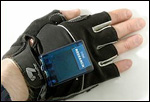Researchers from Intel’s many research laboratories gathered earlier this month at Intel’s headquarters in Santa Clara, Calif., to provide journalists a glimpse into the future. The open house featured a handful of demonstration projects in which RFID plays or could play an important role.
A total of 30 demonstration stations had been set up, and at least twice that number of Intel researchers eagerly provided information on the demonstrations and answered questions. Intel’s senior vice president and chief technology officer, Pat Gelsinger, opened the event with an overview of the company’s research. He noted shifts in R&D investments structure within the company between 1999 and 2004, with more resources moving toward communications and manufacturing applications and away from computing.
Gelsinger also discussed research into new, highly conductive uses of silicon, improved optical technology and smaller, more efficient batteries as factors that are driving progress in R&D at Intel. Improving battery size and function could have long-term benefits to makers of active RFID tags and RFID readers by allowing them to shrink the size of the devices without making them less powerful and without shortening the amount of time they would hold a charge.
A number of researchers from Intel’s Seattle research facility were on hand to give demonstrations of the iGlove, using a glove-mounted RFID reader the facility had developed. Work with this experimental reader is part of a larger Intel research venture called “Guide.” The Guide researchers are trying to create systems that understand and interpret daily activities through auto-identification and statistics. To do this, they use sensor networking, RFID, statistical programming through data-mining, and probabilistic inferencing. Essentially, they configure machines to guess what a person is doing based on how he interacts with objects around him.
This concept was demonstrated at the open house in a simulation of a system designed to help healthcare providers to monitor and care for elderly patients. In the demonstration a researcher wearing an iGlove interacted with RFID-tagged objects. He picked up a teakettle, grabbed a box of tea and opened a sugar bowl. As he did this, the reader collected tag data that identified each of the items, and a computer compared them with a huge database of items and actions that had been mined from the Internet. The system then inferred that he was making tea. In deployment, this information about making tea would be sent over a network and to the caregiver, via a monitor link. Researchers contend that this type of monitoring would keep a caregiver advised of a patient’s status without requiring that the caregiver be constantly present.
In its current state, this iGlove prototype is a fingerless cycling glove with an RFID reader mounted to the top of the hand. The reader is made of an M1-5-232 RFID antenna/reader board from SkyeTek, a Mica2Dot Mote transceiver from Crossbow Technology, and an UBC322030 lithium polymer rechargeable battery from Ultralife Batteries Inc. Together the three components form a box that is 2.5 inches by 2 inches by 0.75 inches. Intel researchers are collaborating with Crossbow and SkyeTek to make a version that will be commercially viable. (For those you who can’t wait, the iGlove assembly and data collection directions are online at seattleweb.intel-research.net/projects/HandheldRFIDReader). But something like TASK could help an organization deploy a sensor network quickly and somewhat independently.
Eventually, organizations could deploy their own wireless sensor networks and incorporate them with RIFD technology, having the sensors carry electronic product codes and function as RFID tags. These tag-sensors could be attached to objects or a shipping container and could then be used to relay information about the environmental conditions that cargo was subjected to while in transit. The tags could also enable people to identify the sensors once they’ve been distributed into an area. The sensors would still be used to relay the information of whatever is being sensed (temperature, humidity, etc.) but the RFID tags could let researchers identify which sensor is transmitting which reading.
RFID Journal University
This special two-day courses presented by RFID Journal and members of Auto-ID Labs addresses the issues you need to understand before deploying RFID/EPC technologies. To learn more, visit RFID U.
|
Washington, D.C. (Reston, Va.) |
June 9 and 10
|
|
|
Chicago |
June 21 and 22
|
|
|
Atlanta
|
July 13 and 14
|
New York City
|
July 26 and 27
|


